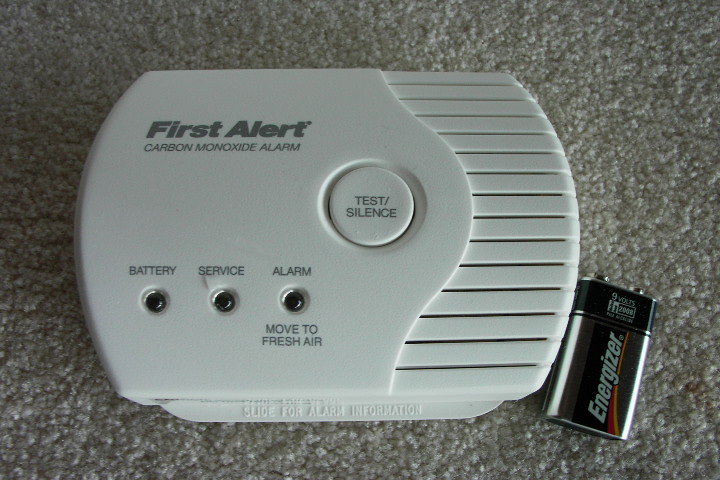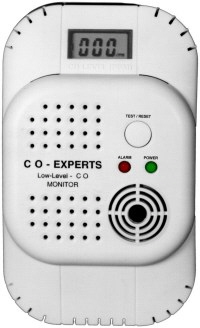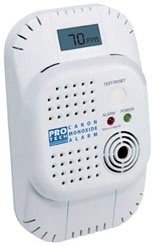|
COMANCHE TOY STORE
CARBON MONOXIDE DETECTOR
by Glenn Plymate, ex-ICS 2658
This story is about a new item I carry in my flight bag now, one I got right after seeing a preview of Omri's "It Should Not Happen To You" column for March.
The accident investigation described in his column was a chilling reminder of the very serious hazard posed by carbon monoxide (CO), and how quickly it can kill. The fact that CO can cause such rapid incapacitation was startling; and it suggests the cockpit of a Comanche is almost as effective as the gas chamber at San Quentin ... if there's a CO leak. But CO is different from the San Quentin stuff. It is colorless and odorless, and is the same density as air. It can't be seen or smelled and mixes freely with the surrounding air. There is no warning.
Ironically, two days before seeing his column I had my own lesson in how insidious the presence of CO can be. I had driven my pickup into my hangar to park it and there were only a few seconds of maneuvering before I shut the engine off. But when I stepped out I could hear an alarm going off in our motorhome parked about 30 feet away. It was a CO detector I had installed two years earlier and this was the first time I had ever heard it alarm. Amazingly, with the huge volume of air in the hangar, there was still enough CO from a few seconds of the pickup exhaust to activate the alarm. I silenced the aural beeping but the alarm light continued to flash ... for several hours apparently, since it gave me a low battery warning the next day.
I was very surprised at the sensitivity of the CO detector. Seeing the report of the UK accident got me thinking one of those might be good for my Comanche.
The "very sensitive" carbon monoxide detector in the motorhome is a First Alert model FCD3N ... made for household use. If CO is detected, flashes a red light and sounds an alarm horn, plenty loud enough to be audible in an airplane. The Owner's Manual claims 85 decibels at 10 feet. It is powered by a 9V alkaline battery which lasts and lasts and lasts. When the battery starts to get tired the unit will chirp and flash twice a minute.
The Manual says it won't detect CO below 15 parts per million (ppm), but will alarm before CO levels become life threatening.
At 100 ppm of CO, the Manual says twenty minutes exposure will not affect average healthy adults. Four hours may cause headaches.
At 400 ppm, 35 minutes exposure may cause headaches. Two hours may cause
death. And it isn't pretty; it can start with a throbbing headache, confusion,
nausea, vomiting, fatigue, a fast heart rate, and, finally, convulsions.
The British report indicated a CO concentration the equivalent of 1,000 ppm breathed for 20-30 minutes. If there had been a CO detector in the airplane, the alarm would probably have sounded even before they completed their run-up. Something was drastically wrong with that airplane and they would have had ample warning to scrub the flight.
Will the First Alert FCD3N work in an airplane? Not if you go by the Manual which says the unit is designed for use in single-family residences. It warns–justifiably or not--that the unit is not to be used in RVs, boats, or airplanes, and cautions it will not work well in turbulent air since blowing air may prevent CO from reaching the sensors.
But it worked in my RV, and surprisingly effectively. CO was introduced in just a
matter of seconds and the alarm went off. So, I decided to get another one and carry it in the airplane.
Yet another surprise; I found Wal-Mart carries First Alert CO Alarms. In February 2003, the on-line price of the FCD3N was $28.73, but in the retail stores they were priced at only $19.97, battery included. It may not be the ultimate alarm, but it meets UL-2034 standards, and for that price it seemed a good thing to carry in the airplane. It will also be handy to take to the motel for overnight stays along the way. At least six Comanche-owning friends have bought them, too.

The First Alert will alarm if there is a rapid rise in CO over a short period, or if there is more than 70 ppm for a longer period. The level of CO will determine how long it takes for the alarm to go off. These sensors seem to be smart and are only intended to warn you when something is wrong and tell you to move to fresh air.
It'd be tough to move to fresh air in a Comanche, so what to do if the alarm goes off? I won't be able to tell what the saturation level is but I'll know things aren't normal; I've got a poison gas--odorless, tasteless, and colorless--mixed in with the air in my cabin and I'd better do something about it. I don't want to be in a position of having to calculate how long I can breathe the poison. Like if it's only 100 ppm, I've got 20 minutes before I start being affected, and 4 hours before I get a headache. Or, like if it's 400 ppm, I'll be affected right away, have a throbbing headache in 35 minutes, and be dead in two hours. It's a question I don't want to deal with. It'd be like having a fuel leak; I don't know how bad it is, if it'll get worse, or how long I can keep flying.
I'd silence the alarm and take action. Open all the vents in the airplane ... get as much fresh air into the cabin as possible ... I've got an emergency. Make sure the heater is off. The sensor will continue to monitor the air but will remain silent for four minutes. If it sounds again, I'd know there's still a dangerous level of CO; my corrective steps are not working and it's time to really get serious about getting on the ground ... head for the nearest airport and land. If I'm IFR, inform Center and request an immediate clearance to the nearest available airport. Declare an emergency if that's what it takes. I'll settle the details later.
Get on the ground and get out of the airplane. Take some deep breaths of fresh air and then try to find the cause of the problem. If it's a cracked exhaust stack like in the accident airplane, the plane doesn't get flown again until the problem is fixed. And, then, only with a properly functioning CO detector on board.
Other Options
There are several devices offered for CO detection, ranging from a low of $3.50 to around $100, and more.
Wal-Mart also carries a Kiddie Nighthawk, model KN-COPP-B. It has a large digital display and is powered by three AA batteries. The unit will show CO levels from 30 to 999 ppm, and has an 85 decibel alarm. It is round; 5 1/4" in diameter and 1 3/8" thick. The LCD screen measures 3/4" by 1 7/8". $39.96.
Aircraft Spruce shows two stick-up spot detectors in its catalog, one good for 28 days and the other for 18 months. These do not rate highly for effectiveness but they are the least expensive of all at $3.50 and $8.95. The spot changes color to indicate CO; and is supposed to show black if the concentration is dangerous.
There is another one shown, too, a 12 volt Digital Carbon Monoxide Detector that depends on external power. It can be permanent or portable, and will give a digital readout of carbon monoxide levels. It also provides an 85 decibel alarm to warn of unsafe levels. $129.95.
Webco offers the CO Buddy, another externally powered unit, but no digital display. $99.95.

Aeromedix.com offers the CO Experts 2002, shown at the left, recommends it "highly for aviation use and other critical environments ….. ", and says it is "ultra-sensitive ….. especially suitable for use in aircraft, boats, RVs ….." $99.95. It has a digital display which will show CO levels from 5 to 70 ppm, and alarm between 70 and 500 ppm with the digital display showing "HI".
It is claimed to have the largest-volume, longest-life electrochemical sensor on the market, and is powered by a 9 volt alkaline battery.
There are three alarm levels, each with a flashing red light and an 85 decibel horn. A low-level CO warning activates between 10 and 25 ppm, and is indicated by two quick beeps and flashes every 60 seconds. The medium-level warning activates between 25 and 50 ppm, with two quick beeps and flashes every 10 seconds. The high-level alarm activates after 60 minutes of exposure to 50 ppm, or 15 minutes of exposure to 70 PPM, and is indicated by four quick beeps and flashes every 6 seconds.
A "hush" button will silence the alarm for a period of time depending on the CO concentration … 12 hours at 10 ppm, one hour at 25 ppm, 6 minutes at 50 ppm, and 4 minutes at 70 ppm.
 EnTech Supply offers a digital display detector which looks identical, the Pro-Tech 7035. $59.85 (or $39.90 wholesale in quantities of 24 or more). This also alarms at 70 ppm and has an 85 decibel horn. But the innards might be different; the digital display will show CO levels from 1 to 500 ppm. The alarm can be muted but will reactivate automatically if CO remains above 70 ppm. It is powered by a 9 volt lithium battery with a 5-year life. An interesting feature, one similar to the CO Experts 2002, is a COHb calculation. It can display an estimate of the amount of carbon monoxide which is potentially bound to hemoglobin … if you really need to know. EnTech Supply offers a digital display detector which looks identical, the Pro-Tech 7035. $59.85 (or $39.90 wholesale in quantities of 24 or more). This also alarms at 70 ppm and has an 85 decibel horn. But the innards might be different; the digital display will show CO levels from 1 to 500 ppm. The alarm can be muted but will reactivate automatically if CO remains above 70 ppm. It is powered by a 9 volt lithium battery with a 5-year life. An interesting feature, one similar to the CO Experts 2002, is a COHb calculation. It can display an estimate of the amount of carbon monoxide which is potentially bound to hemoglobin … if you really need to know.
The pricing of this unit suggests the possibility of a group purchase if some Comanche owners went together.
CO Guardian offers even more options, albeit at heftier prices. Four externally powered 14 volt units are in the lineup, even one with FAA certification. There are two portable models which are designed to plug into a cigarette lighter, and two panel mounted models. The least expensive is a portable. $149, with lights and an 85db horn. For $199, a digital display is included.
For panel mounting, the price jumps to $369 for a non TSO model. It has lights and horn only, and needs a field approval for installation in a Comanche. Top of the line is an FAA certified unit, same features, but at $495.
Should you have one?
If you don't already, reading the accident report in Omri's March column should convince you of the need for a CO detector. They are easy to find, a good selection is available, and they are fairly affordable,
The battery powered alarms appear to have certain common specifications. They all meet Underwriters Laboratories UL2034 standards. They will alarm at 70 ppm with an 85 decibel horn and a flashing light, and will reactivate after 4 minutes, if silenced. Chronic and acute alarm times seem close to the same as well. However, any of these alarms may be less effective in a ventilated space with air blowing across the cover, since the air must reach the sensor for CO to be detected. They should not be placed near an air vent.
For use in an airplane, sensitivity seems vital, and all can claim that. The most important thing is to have some way of detecting carbon monoxide, and have a plan for doing something about it if a leak is detected. For me, I have a non digital model at present but, after studying the options for this article, may want to add a detector that has a digital display as well.
- - -
 Born in Oregon just a few months after Lindbergh's epic flight to Paris, Glenn Plymate first took the controls of a Comanche in 1958. It was only a Piper demo flight but led to part ownership of a 250 Comanche two years later. His education as an architect aided a career in airport planning and construction, airport management, project management, and international airline administration. Now, back in Oregon, Glenn designed and built his personal launch pad, a hangar/home at the Independence Airpark, stocked with two Comanches, a single and a twin. Born in Oregon just a few months after Lindbergh's epic flight to Paris, Glenn Plymate first took the controls of a Comanche in 1958. It was only a Piper demo flight but led to part ownership of a 250 Comanche two years later. His education as an architect aided a career in airport planning and construction, airport management, project management, and international airline administration. Now, back in Oregon, Glenn designed and built his personal launch pad, a hangar/home at the Independence Airpark, stocked with two Comanches, a single and a twin.
|